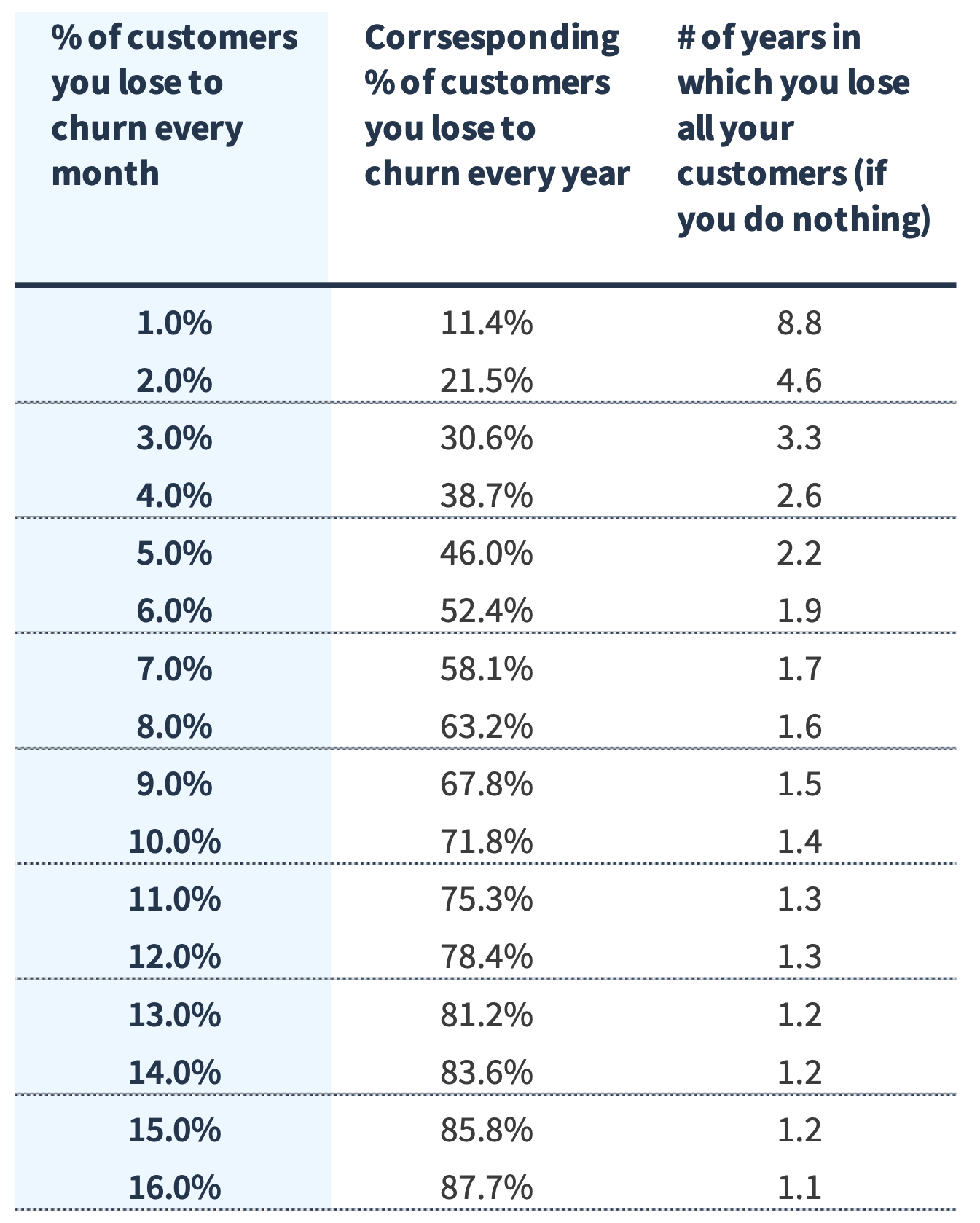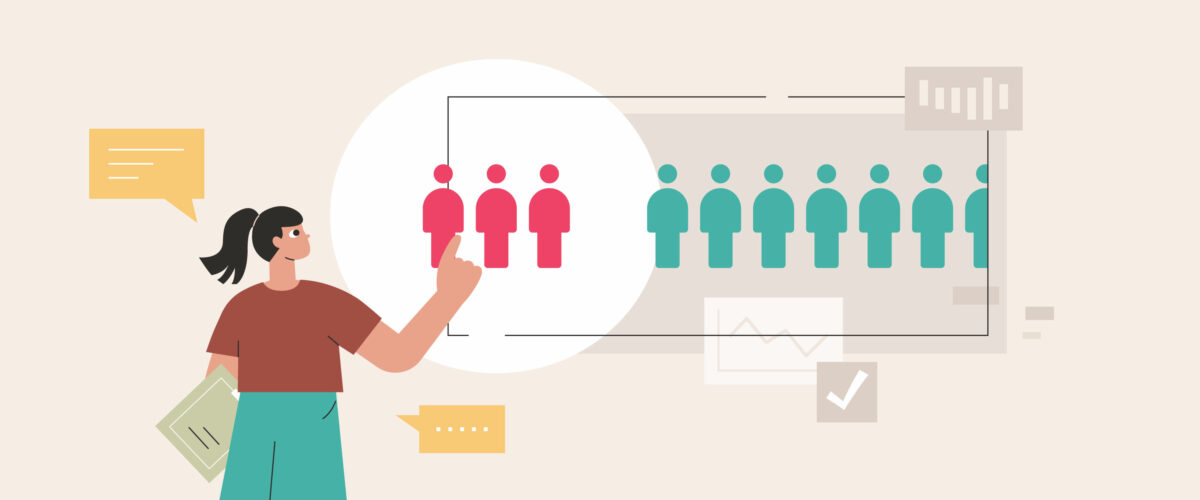Customer churn rate, also known as logo churn rate is a key indicator of the health of your SaaS business. At a high level, it gives you the rate at which your customers are canceling their subscriptions.
A high customer churn rate can be deadly for your business. In this post, we analyze, anonymized and aggregated data from ChartMogul to find out what is a good customer churn rate for a SaaS subscription business.
We also discuss why it is important to track it and the underlying reasons behind a high churn rate.
TL;DR
- Monthly Customer Churn Rate by ARPA & ARR Bands
- How common is negative churn?
- Why Should You Care About Customer Churn Rate?
- How does retention correlate to ARR?
- Why Do Customers Churn?
Monthly Customer Churn Rate by ARPA & ARR
The chart below shows churn benchmarks by a company’s average revenue per account (ARPA) range.
As a reminder, ARPA is the average revenue per account i.e. average MRR across all your customers. It is also known as ARPU or APRC. You can find your ARPA within your ChartMogul Dashboard.
As you’ll notice, the customer churn rate for the median company varies by the ARPA band you are in. For companies with ARPA per month in the range of <$25, the median monthly customer churn rate is 6.1%. It decreases to 2.2% as your ARPA per month increases to >$500.
For companies with lower ARPA, the rate is higher while for companies with higher ARPA it is lower.
The best companies should target a customer churn rate of <2% per month. This goes down to <1% as your ARPA increases.
Below is the data for monthly customer churn rate split by annual recurring revenue (ARR) band.
As you’ll notice, the monthly Customer churn rate of a median company is higher in the initial stages of the business (6.5% for <$300k ARR, 3.7% for those with MRR b/w $1-3M). As companies find product-market fit and hone into their customer category churn reduces. Down to about 3.7% per month. Although it then stabilizes at that level and doesn’t reduce even when a company grows.
The best companies should target a monthly churn rate <2%.
If you have managed to bring down your customer churn to that level, you are already among the top 25% of all SaaS companies. Instead of focusing on bringing down churn further, there may be more important things to tackle.
How common is negative churn?
Churn is high in the initial stages. (See benchmarks above) As you scale and hone in on your ICP, churn decreases. SaaS businesses should target a negative net MRR churn rate. To be considered among the best, you should have a net negative churn ( i.e. net MRR churn rate <0%).
40% of SaaS businesses with ARR in the $15-30m range have negative churn. How can your business achieve negative churn? By building a pricing model that has an expansion loop within it. This is the only sustainable way to get to negative churn. No matter what you do, customers are always going to churn. You need to try to figure out a way to expand revenue from those who stay.
Why Should You Care About Customer Churn Rate?
It is helpful because it gives you:
- Quick feedback — compared to other cohort-based metrics such as Net or Gross dollar/customer retention, churn gives you immediate feedback. You can run tests on your platform and then see feedback in a few days or months.
- Easy to measure — the formula for customer churn rate is straightforward and easy to measure. Also, it is relatively hard to game this metric.
If your customer churn rate is high that means that i) You’ll not be able to compound your user base and hence your revenue, and ii) The money you just spent to acquire your customers i.e. the acquisition cost (CAC) goes down the drain sooner.
Churn is deadly. A monthly churn rate of 5% corresponds to an annual churn rate of 46%. That means you’ll lose close to half your existing customers in the next year if you don’t contain your churn.
Here is a helpful table that helps you look at yearly churn corresponding to a particular monthly churn number.

The formula we use to get the annual churn rate from monthly churn rate is the following:
Annual Churn Rate = (1- (1-Monthly Churn Rate)12)
How does retention correlate to ARR?
Best-in-class customer retention rate at any stage of business stands at ~80%. The dispersion in customer retention is high for startups with less than $300k in ARR. Only a few startups in the early stages experience strong product-market fit. The delta narrows as you go into the higher ARR ranges.
The definition of “good” customer retention depends a lot on who you sell to (consumers, SMB, or enterprise). B2B businesses often have a higher customer retention rate compared to B2C businesses.
Companies with ARPA over $1k/month have a top quartile customer retention rate of 85.8%. In contrast, companies with an ARPA of less than $25/month have a top-quartile customer retention rate of just 64.7%. This is expected. As B2B companies have larger deal sizes, longer sales cycles, and generally more informed decision-making, customer retention is higher.
Best-in-class customer retention for B2B SaaS stands at 90%. Best-in-class customer retention rate depends on your ARPA. For businesses with an ARPA of less than $25/month, it is at 73%. As you move upmarket, best–in–class customer retention increases. For businesses with an ARPA of over $1k/month, it is at 91.9%.
Why Do Customers Churn?
Customers leave you primarily because they don’t see value in your product. The underlying reason as to why they don’t see the value could be threefold:
- They haven’t been onboarded well —
- They can’t get to the ‘Aha’ moment where they get to see the magic of your product. Your product is too complex to understand or they are not sure of what job your product accomplishes.
- Support docs are not easy to understand. Customers are searching for an answer and they just can’t get it. When trying out a new product what you don’t have is time/patience.
- Price doesn’t correlate with value — even if some of your customers see the value in your product, they can get more value for the same price elsewhere. Hence they churn.
- Wrong customer segment — Maybe they weren’t the right customer segment who should be using your product in the first place. Your marketing strategy needs to change in this case. And probably you’ll need to fire some of your customers too.
Unrelated to your product value, there is also some Involuntary churn that happens. This is because of card expiry, declined payments, etc. Customers also leave because they get acquired, and their new home no longer uses your product.
Consider digging deeper to get the real reason behind the churn. A way to do this is to talk to your customers. Find out why they churned? Was it because of your pricing or was it because your product was missing a key feature. And then test your hypotheses (eg. features, pricing, plan). Repeat.
Calculation Methodology. Monthly Customer churn rate is calculated as the ratio of the number of customers who churned in the month (excluding any customers who both joined & churned in the same month) / Total number of customers at the start of the month.
We calculate the aggregates over a 3 month period (Nov ‘21, Dec ‘21 & Jan ‘22). We use the standard B2B churn formula for all companies for easier comparability.
Further Reading
- What Is a Good Net MRR & Gross MRR Churn Rate?
- Understanding and Benchmarking Your MRR Movements
- What Is a Good Monthly Growth Rate for SaaS Startups?
- SaaS Benchmarks Report

